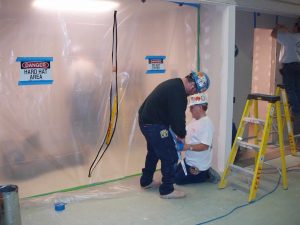by Bert Durand
A hospital needs to build an addition or renovate existing space. Is the bid price the most important consideration? What about the financial and health risks of hiring an unqualified company? You’d have to consider the impact such a move would have on the bottom line of the entire facility, not just the construction project, wouldn’t you?
In addition to the normal concerns construction users have about quality, durability, and cost, healthcare providers have more to consider. Healing patients is a complicated task, one that gets much harder when contaminants from the materials, process, and workers involved in a building project are introduced.
The United Brotherhood of Carpenters and employer partners have developed a training program for apprentices and journey-level workers called Infection Control Risk Assessment (ICRA). The curriculum was developed through a cooperative effort of national leaders in healthcare, construction management, and union training programs and aims to address the specific concerns of these unique building projects.
Once developed, the ICRA program was taught at the union’s International Training Center to hundreds of UBC trainers who took it back to their local areas and held classes with carpenters in the field.
The ICRA curriculum, in part, includes teaching awareness of hazards, including asbestos, lead, mold, silica, and other materials, as well as blood-borne pathogens and other hospital-specific concerns. Trainees learn how to identify and classify work areas to maintain an environment that can minimize risks, illness, and injury. Specialized clothing and equipment are part of the package.
Local healthcare facilities gain peace of mind that not only are union workers earning a decent wage, they’re provided decent healthcare benefits that allow them to get treatment in the very facilities they’re building. They’ve got the cutting-edge skills to ensure healthcare providers offer the best care during and after the project is complete.
The investment in the program is significant, but because it is made on a national level between labor and management partners, it provides a tremendous bang for the buck.
Union carpenters and contractors are rightly proud of the ICRA program. It provides a competitive advantage in bidding to facilities that truly care about treating patients in a health environment. And it highlights the cooperative effort that leads to better building.
The ICRA program has been implemented the way many other UBC training programs have made their way from industry leaders to hands in the field.
The Carpenters International Training Fund (CITF) is one of the country’s largest producer of text books. Its online Build-a-Book program lets training coordinators across the country pull standardized chapters from more than 80 CITF textbooks to create state-of-the art, targeted curriculum and companion instructor materials that cross all skill sets.
Here in New England, union carpenters train at 17 locations, including the Carpenters Center in Boston and the New England Carpenters Training Center in Millbury, Mass.
Bert Durand is communications director of New England Regional Council of Carpenters.











